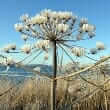Background
- Cow parsnip (Heracleum maximum) is the only member of the hogweeds that is native to North America. Like other hogweeds, cow parsnip sap can cause blisters and phytophotodermatitis. There is currently insufficient evidence available in humans to support the use of cow parsnip for any indication.
- Some Native American tribes used cow parsnip to treat bruises and sores.
References
Natural Standard developed the above evidence-based information based on a thorough systematic review of the available scientific articles. For comprehensive information about alternative and complementary therapies on the professional level, go to . Selected references are listed below.
- Kriazheva SS, Khamaganova IV, Kolibrina AM. [Dermatitis bullosa in children caused by cow-parsnip]. Pediatriia. 1991;(6):88-90.
View Abstract - Maksakova GP. [Case of contact dermatitis caused by Sosnovskii's cow parsnip]. Vestn.Dermatol Venerol. 1978;(8):48-49.
View Abstract - Prinz VL, Kostler H. [Report on 3 cases of toxic phytophotodermatitis due to Heracleum mantegazzianum (giant cow parsnip)]. Dermatol Monatsschr. 1976;162(11):881-886.
View Abstract - Rogov VD. [Acute bullous dermatitis developing after contact with cow parsnip (Heracleum)]. Vestn.Dermatol Venerol. 1985;(11):58-59.
View Abstract - Sokolova EM. [Bullous occupational dermatitis caused by the cow parsnip]. Vestn.Dermatol Venerol. 1968;42(2):64-67.
View Abstract







